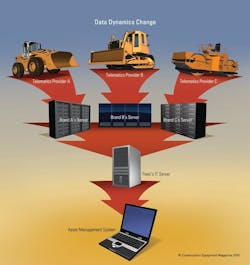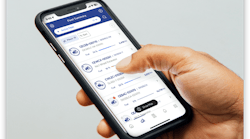Although telematics is a word frequently bandied about in the construction industry, a number of fleet managers confess they still don’t get it. They remain a little fuzzy on what it is, what it does, and what it is supposed to do to help them make better business decisions.
Telematics made its industry debut at Conexpo in 1999. It started out “as a very expensive box that used a variety of sensors to access a telecommunication system,” according to Al Cervero, vice president and construction sector leader at the Association of Equipment Manufacturers (AEM).
“That system, in turn, sent signals up to an LEO (low earth orbit) satellite to download data,” he says. “The technology has come a long way from that time when cell phones were about the size of a shoe. Today the primary communication system is cellular.”
At the present time, the majority of off-road fleets use the most basic approach offered by the technology. They track hours of service to facilitate more accurate utilization and scheduling of maintenance. They use it also to track project/job bidding, machine use and uptime, and, in some cases, risk management and equipment life cycles.
Telematics data can monitor a variety of functions such as fuel efficiency, labor savings, PTO loads, outside temperatures, GPS distance traveled by a piece of equipment, and odometer readings. “The key point here is that telematics isn’t just a value for fleet managers,” Cervero says. “Many departments within an organizations have found it useful in their respective areas of responsibility.”
Larger companies that have achieved higher levels of data integration are tracking operator efficiencies, as well, coupling that with asset intelligence to shape process and training improvement.
Mega fleets already are using telematics to its full advantage, Cervero says.
“One global contractor who operates equipment in an African country told me he saved $33,000 a month just being able to monitor the speed and capabilities of his trucks and train the operators to do things just a little bit differently,” says Cervero. “It’s not the things you expect to achieve with telematics, such as count the machines, check them out, fill them up, but it is the new efficiencies in time and money you didn’t even expect to find. It’s not just the fleet manager who benefits from telematics, but also other departments, such as logistics and billing. Each department is discovering it own new uses and efficiencies for telematics.”
Another large fleet, Cervero says, initially embraced telematics for the purpose of doing only daily work. Now they are finding other surprising benefits, including time and money savings, almost on a daily basis.
“The biggest savings is in idle time,” Cervero says. “By just looking at idle time, fleet managers rearrange, re-manage and refocus their fleets. And that’s not even considering fleets operating in states where OSHA regulations limiting idle time to 5 minutes are strictly enforced. If you can download a report that shows a machine idled only 3 minutes and 58 seconds and not 5 minutes, you can show you are in compliance and avoid paying fines that can be significant.”
The technology has advanced to such an extent that OEMs are installing it on machines as they come off the production line at the factory. Nevertheless, Cervero says, manufacturers have had a nagging feeling all along that end-users weren’t taking full advantage of what telematics has to offer.
Fleets frustrated with telematics
The Association of Equipment Management Professionals (AEMP) has been on the receiving end of numerous complaints and frustrations expressed by the association’s member organizations and, according to Stan Orr, CAE, president and chief strategy officer for AEMP, “a more vocal group of end-users.”
The complaints triggered a first-of-its kind industry survey of telematics (p.26 in the Winter 2013 issue) use among construction fleets, spearheaded by AEMP. The study was funded by AT&T and implemented independently by INEX Advisors.
AT&T became involved due to its “interest in connecting fleets of machines to the cloud so operators can optimize their usage and maintenance of equipment and generate additional revenues and margins,” says Mobeen Khan, executive director, advanced mobility.
INEX gathered information through lengthy telephone interviews and online surveys, “with protections in place for the individuals who participated,” says INEX founder and president, Christopher Rezendes. About 50 or 60 fleets ranging in size from mega to large, and from medium to small were surveyed, and 80 individuals were interviewed, some more than once, says Rezendes. “Nothing was shared, except by two members of the research team and the Technology Futures Group at AEMP. Even today, AT&T does not know the names, titles or specific companies that participated.”
Rezendes noted that while existing industry information was solid and useful, researchers “did not want to plow the same old ground.
“Most people think of research as just the process of collecting data,” he says. “It’s not how data is collected. We have a dig-deeper concept about how the data will be processed and how it will be exploited to determine whether to disseminate or share it and, if so, with whom and under what conditions.”
AEMP presented the research results to AEM to demonstrate why this is a genuine problem, why telematics is not being used, and also came up with suggestions of what needs to be done about it, according to Orr. “The survey got all of us off the dime,” he says.
Despite the significant investment OEMs have made in refining and advancing the technology (it helps them build better, safer and more efficient machines), the lack of enthusiasm among construction fleets has become so prevalent that at the conclusion of the study researchers described its use as “shockingly low.” About the only exception were mega fleets. Other companies with fewer units are using telematics in bits and pieces to retrieve data. But even that data, while useful for maintenance purposes, they say, don’t provide the information asset managers need to better manage their fleets.
The AEMP survey results made it quite clear that end-users want more information than existing telematics standards now provide. And they want the data centralized and standardized so they can get to it with less effort.
Aggregation aggravation
Needs of end-users are so diversified that it is impractical to assume that one size fits all. That holds particularly true for mixed fleets. Just to retrieve the data is a Cecil B. DeMille production. Asset managers have to access different OEM websites to capture specific data applicable to their individual operations. Data are downloaded separately for each brand.
“Each manufacturer measures utilization a little differently,” says Kendall Delp, global asset manager for Ameco. “Productivity data would help us better manage our fleets. For example, if there was a way for us to measure productivity of a wheel loader with a certain size bucket, in addition to load weighing system, now we’re getting into productivity.
“The fact that we have to go to each manufacturer’s website to gather some of those details is what makes telematics cumbersome to use in helping us do our business,” he says.
Tripping up the fulfillment of that request, however, are major concerns about aggregated data on the part of both OEMs and end users. Manufacturers want to protect proprietary data. End users fear aggregating their company’s data could provide insight on how they do business, thus giving unfair advantage to competitors.
“I have a right to all that data if I own the machine,” says Don Gengelbach, CEM and fleet manager at Mulzer Crushed Stone. “By the same token, it is my responsibility to keep that data confidential. I can’t broadcast it to everybody, and OEMs can’t put that data out on a cloud for everybody to grab it up.”
Based on the survey, AEMP concluded that each segment of the industry had to work together to create an acceptable method that would standardize the data and make it easier to access.
Manufacturers agreed, and an AEMP telematics initiative with AEM to resolve the problem has been set in motion.
“Fleet managers are interested in the perceived benefits of telematics, but are being pushed in so many directions on how and what to use to integrate that they have reached the point where they go into vapor lock,” Orr says. “Many would-be telematics users don’t know which systems are best. On top of that, they are wary of the costly integration fees that may be charged by third-party software companies.
“If you are a big fleet with 20 different brands, you’re talking pretty serious dollars that represent a huge investment,” he says. “Even if you are a small fleet, it is a significant investment. It’s all relative.”
Gengelbach concurs. “I am responsible for a fleet of 400 to 450 off-road units and 200 to 225 on-highway vehicles. Third-party monthly fees could run $30 or more per piece of equipment. It depends on how much data you want, whether you want satellite or cellular. Everything is negotiable, but for a company our size these fees are pretty scary.”
Although the use of telematics by most fleets is now selective and narrow, the challenge of AEM and AEMP working in tandem is to find an easier and a common way for construction fleets to “look at the data as a company fleet, not as a manufacturer,” Cervero says.
“AEM has been nothing short of outstanding to work with,” says Orr. “They have acted in such a way that is very encouraging.”
Despite the challenges confronting acceptance on a larger scale, Cervero says, “I think we will be significantly successful in a very short time.”





